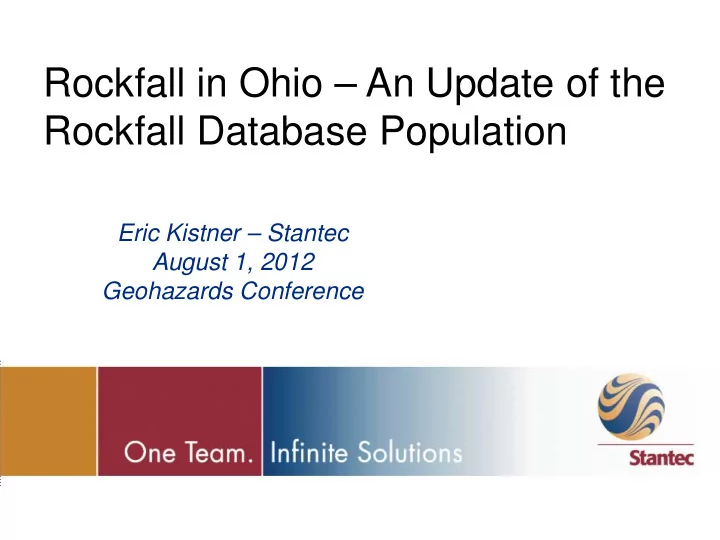

Rockfall in Ohio – An Update of the Rockfall Database Population Eric Kistner – Stantec August 1, 2012 Geohazards Conference
Presentation Outline Rockfall in Ohio – An Update of the Rockfall Database Population I. Introduction II. Site Identification III. Site Tiers IV. Field Data Collection V. Database Population VI. Results VII. Remediation Cost Estimating
I. Introduction ODOT Geohazards Management System (GHMS) • Landslides • Underground Voids • Rockfall – Manual for Rockfall Inventory (ODOT OGE, January 2009) – From the manual: “…rockfalls constitute a major hazard along Ohio roadways, posting a risk to life, property and public safety.” – Risk assessment process to prioritize rockfall prone sites
I. Introduction Why was Rockfall process developed? • Rockfall prevalent in Ohio, especially unglaciated areas • Problems with past rockfall – Highway closures – Property damage – High repair costs • A need to be proactive – Public Safety – Budgetary Mechanism – Informational Resource
II. Site Identification Site Criteria • Natural or manmade slope with exposed bedrock, i.e. “rock slope” • At least 10 feet tall (normally) • Not longer than 1 mile • Not crossing county lines
III. Site Tiers Determined by: • Potential of rockfall occurrence • Potential of rockfall reaching travelled lanes Tiers: • Tier 1 – low to moderate, low to moderate • Tier 2 – moderate to high, moderate • Tiers 3/4 – high to very high, high to very high
III. Site Tiers Preliminary Rating Potential of Potential of Rockfall Impacting the Traffic Lane Rockfall Very High (10) High (8) Moderate (4) Low (1) Occurance Very High (10) High (8) 12 Moderate (4) Low (1)
III. Site Tiers Tiered Approach to Data Collection Preliminary Rating Score Required Data Risk Assessment (PRS) Sections Criteria PRS = 2 to 5 Preliminary Rating Preliminary Rating Only (Tier 1 Sites) Only Site Location, General, PRS = 8 to 11 and Interview Part A Only (Tier 2 Sites) Information; GPS Files PRS = 12 to 16 Traffic, Maintenance, (Tier 3 Sites) Accident, Geological, Part A, Part B, Part C Slope, Hydrological, PRS = 18 to 20 Rock Sampling (Tier 4 Sites) Information
IV. Data Collection Field Equipment
IV. Data Collection (Performed by PSI – Columbus, Ohio) Criteria Required for All Sites • Beginning/Ending Mileage Point • Orientation/Position of Rock Slope • Lat/Long/Elevation
IV. Data Collection Tier 1 Sites • Slope Configuration – Single-Angle – Multi-Angle – Single-Angle Benched – Multi-Angle Benched • Slope Condition – vegetation cover, talus buildup, weathering, etc. • Photographic Documentation
IV. Data Collection Tier 2 Sites • Geometrics and Traffic Survey Data • Additional Slope Information – Slope height – Overall face angle – Undercutting features – Jointing patterns – Catchment dimensions – Corrective actions and effectiveness
IV. Data Collection Tier 3/4 Sites • Add’l Slope Geological Conditions such as: – Bench elevations and widths – Slope angles and elevations – Potential rockfall volume estimations – Talus accumulation information • Hydrological conditions (springs, seeps,etc.) • Slake Durability Index (SDI) testing • Road slope and detour distance/time
V. Database Population Site Listing
V. Database Population Preliminary Rating
V. Database Population Site Location
V. Database Population Basic Slope Information
V. Database Population Geologic Information
V. Database Population Joint Information
V. Database Population Slope Information
VI. Results Statewide Map RED Rockfall Sites > 400 ORANGE Rockfall Sites > 200 YELLOW Rockfall Sites > 100 GREEN Rockfall Sites > 50 LIGHT GREEN Rockfall Sites > 0
VI. Results Statewide Summary # of Rockfall Sites 5,540 100% Tier 1 3,997 72% Tier 2 1,040 19% Tier 3 484 9% Tier 4 19 0.3%
V. Database Population Risk Analysis Score
Score Summary Tier 3 Sites Tier 4 Sites Tier 2 Sites 419 260 216 171 3
VII. Remediation Cost Estimating RCDA – Remediation Cost Database and Application • Web-enabled cost estimating application developed by OSU • Plan scenarios – Flatten the rock slope – Widen the catchment area – Placement of a New Jersey or modified D50 concrete barrier – Trim blasting of a rock overhang – Manually scaling the slope
VII. Remediation Cost Estimating Statewide Average Remediation Costs Remediation Scenario Cost ($) / Foot Site Length New Jersey Barrier 87 Modified D50 Concrete Barrier 101 Scaling 164 Trim Blasting 240 Flatten Slope 1,885 Flatten Slope with Added Catchment 2,392
VII. Remediation Cost Estimating Scaling COS-36
VII. Remediation Cost Estimating Trim Blasting After Before GUE-22 North Slope
VII. Remediation Cost Estimating Trim Blasting/Draping After Before GUE-22 South Slope
Closing • Ohio (esp. southeast Ohio) contains rockfall-prone bedrock formations. • ODOT has established a risk-based inventory for rockfall-prone sites. • ODOT is utilizing the inventory to systematically remediate the highest risk sites. • Questions?
Recommend
More recommend